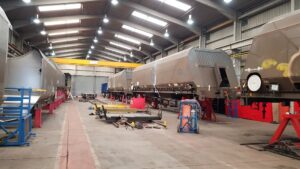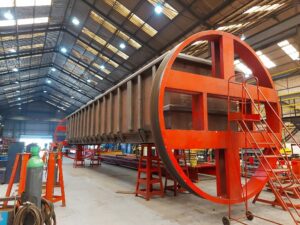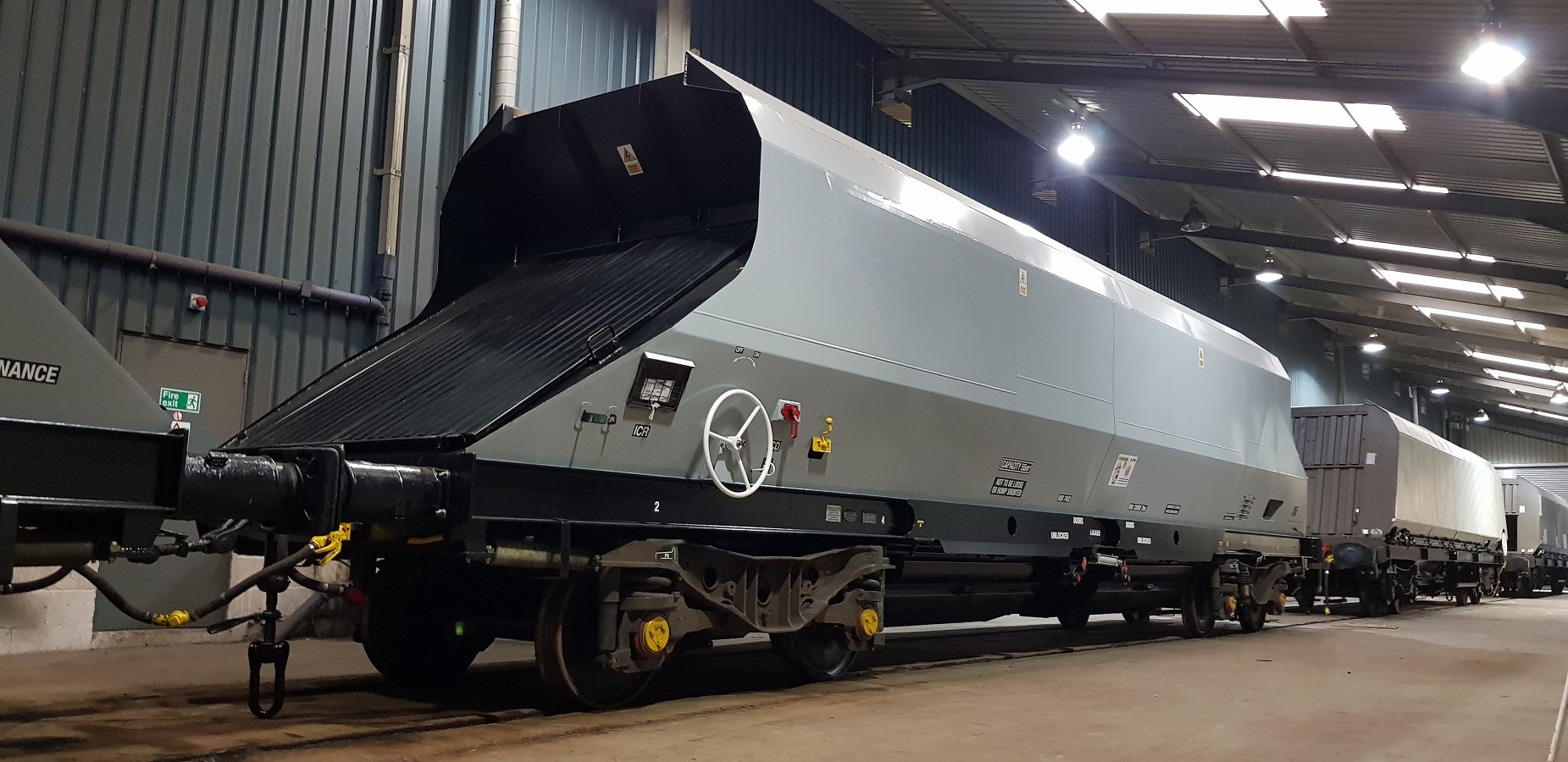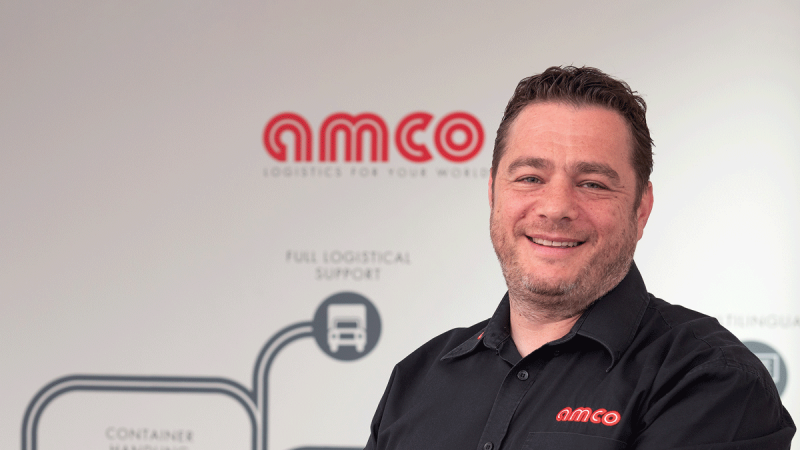WH Davis has been working from its current site for over 115 years since it was founded in 1908. Originally, the firm built small two-axle wooden wagons for the local mining industry. From there the company progressed to building and repairing wagons for rail transport and continued to work in the sector until today. It is a long history that has seen the company become the last independent British rail wagon manufacturer.
“We provide wagons for a number of the leasing companies in the UK and other businesses, such as GB Railfreight and Drax,” says Les Bryant, Group Engineering Director of WH Davis Group. “We have the facilities to fully design and build the vehicle from scratch. We can offer customers a full turnkey service with our sister company in the group, Davis Wagon Services, the largest Independent wagon maintainer in the UK. We have the capability to design, build and maintain the wagon.”
As the last independent wagon manufacturer in the UK, WH Davis fulfils a unique and critical role in the British supply chain. It is a position that gives Bryant a unique perspective on the challenges facing the sector.
“I’m pushing to support the British supply chain, both for ourselves and all the businesses around us,” Bryant insists. “We use local steel companies to provide the basis of our products. When we overhaul components, we use British companies like Yellow Rail and Sabre. My message is, if you don’t support your local supply chain, the skills and expertise will move off-shore and you’ll have no option but to take it abroad or be unsupported in your business and industry.”
Protecting the Supply Chain
 It is a challenge that Bryant understands only too well. WH Davis is competing against huge American corporations operating out of Europe, manufacturing in Romania and Poland, which can put its British counterpart at a disadvantage when it comes to the costs of labour.
It is a challenge that Bryant understands only too well. WH Davis is competing against huge American corporations operating out of Europe, manufacturing in Romania and Poland, which can put its British counterpart at a disadvantage when it comes to the costs of labour.
But as well as dealing with the challenges of British labour costs, there are also added costs in sourcing materials and parts from Europe.
“We are dependent on the European supply chain for components such as buffers, and brake equipment, because there are no UK companies that do that,” Bryant points out. “We are trying to get people to understand our position and to buy British.”
Bryant’s point is that this is not just about the fortunes of WH Davis itself, but about the fundamental infrastructure of Britain’s rail freight supply chain as a whole.
“The commercial structure of the rail freight industry in the UK is a big issue,” he tells us. “The freight sector is fully commercial, nothing like the passenger sector. We make a profit and survive, or we don’t and die. We have no government backing, subsidies or grants to put that support in there and make the sector stable.”
As Bryant points out, when a passenger franchise goes wrong, the government steps in and runs it, but if an intermodal company goes bankrupt there is no one to step in and run those intermodal services carrying key goods and products for the UK economy.
“For all their soundbites, they have no comprehension of how important the UK Rail Freight industry is to the British economy,” Bryant says.
A Changing Industry
To survive, the industry needs to evolve, and WH Davis has been taking steps to do just that.
“We try to innovate,” Bryant says. “We are always looking for ways to become more efficient.”
In many industries, that means automation, but WH Davis faces unique challenges when it comes to implementing that.
“We look at where we can use automated processes, but building a wagon is not like volume car production where the economics allow for large-scale investment in automation,” Bryant tells us.
Part of this is due to the markets WH Davis is serving. Wagon designs are specific and to-purpose, which tends to mean smaller volumes of specific models compared to volume manufacturing. Lots can be as small as 25 to 100 of any given wagon. But as Bryant points out, there is more to the challenges of automation than volumes alone.
“There are parts of wagon manufacture that need a human element,” he says. “Wagons are such large objects that there can be a few millimetres of difference between one vehicle and another. So when you preprogramme the robots and they go to a step spot, that two millimetres might make all the difference.”
Another issue with the markets that WH Davis is serving is the tight margins in which the operators work to mean that there are infrequently monies available to allow suppliers to provide innovations which all add to the cost of the vehicle.
 “There is technology out there for wagons readily available such as WSP systems, Derailment Detectors and load sensing systems,” Bryant says. “We now offer that to all our customers. When I send an offer out to a customer for a wagon they have asked for, I give them an options list like a car.”
“There is technology out there for wagons readily available such as WSP systems, Derailment Detectors and load sensing systems,” Bryant says. “We now offer that to all our customers. When I send an offer out to a customer for a wagon they have asked for, I give them an options list like a car.”
It all comes down to the financial structure of the rail freight industry, where the bottom line is king.
“It includes the features they have asked for but adds that other options are available at an additional price,” Bryant explains. “But we can only ever offer the innovation, it’s up to the customer if they want to take it based on price. And often price concerns come out ahead because we are a fully commercialised industry.”
Securing Freight’s Future
Of course, where automation is unable to reach, human resources are more valuable than ever. However, here too Bryant points out potential risks for the sector.
“We, like a lot of companies, particularly in the UK, have difficulty finding competent, qualified, staff,” Bryant says. “We take apprentices on. We just took on a new group recently. We try to encourage apprenticeships, but at the moment heavy engineering does not seem to be fashionable to most of the current generation. They don’t want to work in big workshops doing heavy-duty manual labour anymore.”
While WH Davis is doing what it can, Bryant argues that more fundamental solutions are needed. It means changing the very way we perceive heavy engineering.
“There is no quick fix for it,” Bryant says. “I think there is a cultural and societal change that’s got to come before we start to see people wanting to come back into this type of industry.”
These are the challenges WH Davis is facing, but he remains optimistic for the future, looking at ways to increase the company’s offering.
“We want to expand the portfolio of vehicles we manufacture,” Bryant says. “We are good at bespoke types of vehicles, and we are actively improving our customer service, back-up and warranty support, and we are looking to try and push innovation through to the customer. But nothing is free.”
Bryant concludes, “I have a simple saying, we can build anything you want if you are willing to pay for it.”







